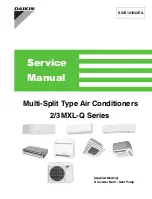
6 Disposal
Installation manual
12
(A)RXP20~3 RXF20~3 RXF20~25B5V1B
R32 split series
3P519299-2H – 2019.09
The
outdoor unit
is properly mounted.
The system is properly
earthed
and the earth terminals
are tightened.
The
power supply voltage
matches the voltage on the
identification label of the unit.
There are NO
loose connections
or damaged electrical
components in the switch box.
There are NO
damaged components
or
squeezed
pipes
on the inside of the indoor and outdoor units.
There are NO
refrigerant leaks
.
The
refrigerant pipes
(gas and liquid) are thermally
insulated.
The correct pipe size is installed and the
pipes
are
properly insulated.
The
stop valves
(gas and liquid) on the outdoor unit are
fully open.
The following
field wiring
has been carried out according
to this document and the applicable legislation between
the outdoor unit and the indoor unit.
Drainage
Make sure drainage flows smoothly.
Possible consequence:
Condensate water might drip.
The indoor unit receives the signals of the
user interface
.
The specified wires are used for the
interconnection
cable
.
The
fuses, circuit breakers,
or locally installed protection
devices are installed according to this document, and
have NOT been bypassed.
5.2
Checklist during commissioning
To perform an
air purge
.
To perform a
test run
.
5.3
To perform a test run
Prerequisite:
Power supply MUST be in the specified range.
Prerequisite:
Test run may be performed in cooling or heating
mode.
Prerequisite:
Test run should be performed in accordance with the
operation manual of the indoor unit to make sure that all functions
and parts are working properly.
1
In cooling mode, select the lowest programmable temperature.
In heating mode, select the highest programmable temperature.
Test run can be disabled if necessary.
2
When the test run is finished, set the temperature to a normal
level. In cooling mode: 26~28°C, in heating mode: 20~24°C.
3
The system stops operating 3 minutes after the unit is turned
OFF.
INFORMATION
▪ Even if the unit is turned OFF, it consumes electricity.
▪ When the power turns back on after a power break, the
previously selected mode will be resumed.
5.4
Starting up the outdoor unit
See the indoor unit installation manual for configuration and
commissioning of the system.
6
Disposal
NOTICE
Do NOT try to dismantle the system yourself: dismantling
of the system, treatment of the refrigerant, oil and other
parts MUST comply with applicable legislation. Units
MUST be treated at a specialised treatment facility for
reuse, recycling and recovery.
6.1
Overview: Disposal
Typical workflow
Disposing of the system typically consists of the following stages:
1
Pumping down the system.
2
Bringing the system to a specialized treatment facility.
INFORMATION
For more details, see the service manual.
6.2
To pump down
DANGER: RISK OF EXPLOSION
Pump down – Refrigerant leakage.
If you want to pump
down the system, and there is a leak in the refrigerant
circuit:
▪ Do NOT use the unit's automatic pump down function,
with which you can collect all refrigerant from the
system into the outdoor unit.
Possible consequence:
Self-combustion and explosion of the compressor
because of air going into the operating compressor.
▪ Use a separate recovery system so that the unit's
compressor does NOT have to operate.
NOTICE
During pump down operation, stop the compressor before
removing the refrigerant piping. If the compressor is still
running and the stop valve is open during pump down, air
will be sucked into the system. Compressor breakdown or
damage to the system can result due to abnormal pressure
in the refrigerant cycle.
Pump down operation will extract all refrigerant from the system into
the outdoor unit.
1
Remove the valve cap from the liquid stop valve and the gas
stop valve.
2
Carry out forced cooling. See
3
After 5 to 10 minutes (after only 1 or 2 minutes in case of very
low ambient temperatures (<−10°C)), close the liquid stop valve
with a hexagonal wrench.
4
Check on the manifold if the vacuum is reached.
5
After 2-3 minutes, close the gas stop valve and stop forced
cooling.
Summary of Contents for ARXP20L5V1B
Page 15: ......


































